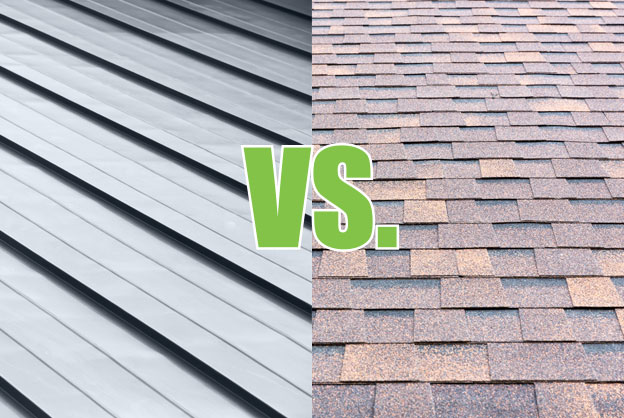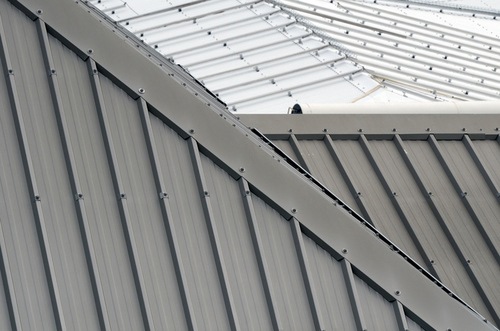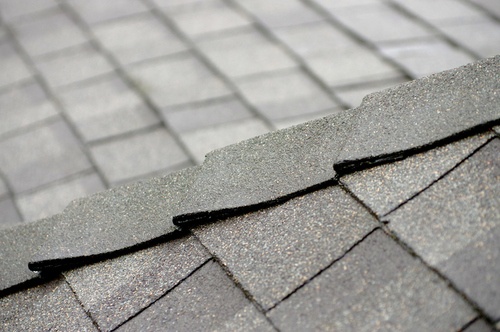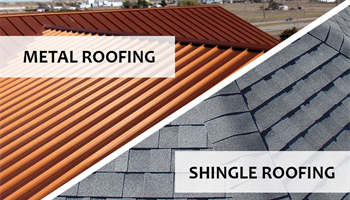METAL ROOF VS. SHINGLE ROOF: THE PROS AND CONS OF EACH
If you’re in the market for a roof replacement, or buying a new home, it’s important to know your roofing options. There are a lot of different materials used to construct a building and those materials have an impact on the aesthetics, functionality, and longevity of your home. While many people focus on the interior and specific details of the exterior, an often-overlooked area is the roof. Roofing material doesn’t usually cause much speculation other than, does it look nice or not. However, your roof is your home’s first defense system and the type of material used to construct it makes a big difference. In this article, we’ll explore some of the pros and cons of a metal roof vs. shingle roof so you can better understand your roofing options.
The Difference Between Metal vs. Shingle Roofs
Before we dive right into metal vs. shingle roof pros and cons, it’s important to have a strong grasp on the underlying differences between a metal roof and a shingle roof.
A metal roof is a blanket term for a roof that’s constructed from a variety of different metals. Metal roofs are available in tin, steel, aluminum, and even copper and zinc. Needless to say, metal roofs are a bit more complex than shingle roofs. While metal has traditionally been used for commercial or industrial buildings, it’s recently made its way into residential buildings.
A shingle roof is the more common type of roofing you see in residential areas. They’re constructed using small pieces of asphalt shingles and is seen as the “traditional” type of roof used for most homes.
So what are the pros and cons of each?

Metal roofs tend to be more durable.
Metal roofs can stand up to nearly anything Mother Nature throws at them, so you’ll find that they come with 30- to 50-year warranties, and often outlast that with lifespans of 40 to 70 years. Metal roofs are not without weaknesses, however: Extreme hail or falling branches could dent a metal roof, as could walking on it improperly. Discuss vulnerability concerns with the manufacturer. You’ll learn, for example, that steel is hardier than copper.
Shingles have a shorter lifespan due to their own unique set of weaknesses. Pooling water and chronically damp conditions can lead to algae and fungus growth, ice dams can create cracks, and temperature spikes between day and night can reduce the life of your shingle roof. Shingle roofs come with 15- to 30-year warranties, depending largely on the region, environment, and climate.
Metal roofs are more eco-friendly.
Because they’re largely made of recycled material and can be recycled again and again, metal roofs are considered a more sustainable choice than asphalt shingles. Metal roofs are also more energy-efficient thanks to their reflective qualities, which can block heat transmission to the home’s interior. Specialized paint coatings can further reduce your cooling bills. Asphalt shingles, on the other hand, need to be replaced more frequently than metal roofs; it’s estimated that U.S. landfills receive nearly 20 billion pounds of old asphalt shingles annually. Also, asphalt shingles are a petroleum-based product, which increases dependency on fossil fuels.
Asphalt shingle roofs generally are easier to install and repair.
For pros, the work requires little specialized knowledge and basic tools. Shingles can be installed in a day or two in some cases, sometimes right over the existing layer. Metal roofing installation typically requires a more skilled and specialized tradesman. The job is more precise, with less room for error, so it won’t move as quickly as a shingle installation. However, some lightweight metal products may be able to be installed right over an existing roof in good condition, simplifying installation overall and eliminating the cost of ripping the original roof out.

Varieties
Metal roofing comes in a variety of styles, largely dependent on the metal used and coatings applied. Aluminum is a metal that needs no coating. Steel, on the other hand, requires specialized treatment to prevent rusting. Other metals used for roofing are copper, zinc, stainless steel, and titanium.
Asphalt shingles come in two varieties, the newer fiberglass shingles and traditional organic ones. The difference is in their layered make-up. Fiberglass shingles have a fiberglass 3 core covered with an asphalt layer. Organic shingles have a heavy felt layer under the asphalt.
Appearance
The layered look of asphalt shingles is by far the more popular of the two types. The vast majority of homes in the United States have asphalt shingles, largely because asphalt is the material most builders trust and what homeowners are accustomed to seeing on houses. Asphalt shingles can vary in colors to match the paint or brick of a home, and the variety of their colors is more than with metal roofing. The three-tab shingles give a flat appearance while the more expensive architectural shingles appear more three dimensional.
Metal roofs are rarely seen in urban and suburban areas. The sleek, metallic appearance seems more suited for an agricultural setting. Metal roofing does come in a variety of colors and styles to match the rest of the home. The metal can be in panels, tiles, or shingles, but the look of a metal roof still can be jarring in a neighborhood full of asphalt shingles.

What to Consider Before You Choose a Metal or Shingle Roof
Your roof not only protects your home and the items on the inside, it also keeps you and your loved ones safe, which is why choosing the right roof based on your individual needs is vital. Start the decision process by evaluating the following aspects.
Your Budget
Between metal roofing and shingle roofing, the biggest factor to consider is how much money you have to spend and are willing to spend at one time. If you have a lower amount of money or small cash flow to spend at one time and don’t mind the idea that you’ll have to replace the roof in 15-20 years, a shingle roof is your better option. Or, if you have more money to put down at one time or want the peace of mind that your roof won’t need to be replaced for at least 60 years, a metal roof is the best choice
Your Roof Design
Every roof is different, which could really make a difference when choosing the best material for your roof. Get to know your roof by finding out:
- Roof pitch (slope)
-
- It’s imperative to check the manufacturer’s minimum and maximum slope requirements for both metal and shingle roofing before installation, as it could be restricted based on different products or materials.
- Square footage of the roof
- The complexity of the design of the roof, including the number of dormers, valleys, hips, skylights, penetrations, flashing points, and vent pipes
- How much and what parts of the roof are in the shade and in the sunlight
The Building’s Lifecycle
Knowing the predicted lifecycle and use of the building or home the roof will be going on is just as important as knowing your roof design. For example, is the building or home older and in need of extreme renovations or tear-down within the next 20 years? Go with a shingle roof. Or is the building or home newer and likely to last five decades or longer? Go with a metal roof.
Your Environment
There are definitely environments where a metal roof or a shingle roof is the better choice. For example, if you live anywhere threatened with potentially high winds or extreme heat, metal roofing can help alleviate some of those concerns. Or if you live in a very mild environment where you are less concerned with extreme weather, a shingle roof will work just fine too.

How are Metal Roofs Better?
Metal roofs reflect the sun, which reduces the amount of heat penetrating the home. A reflective roof can reduce peak cooling demand by 10 to 15 percent, according to the Dept. of Energy. That, in turn, means the home’s cooling system needs less energy to cool the house.
Some metal roofs can save up to 25 percent in energy costs compared to a dark gray asphalt shingled roof, according to the DOE’s Oak Ridge National Laboratory (ORNL).
Some metal roofs come with warranties of up to 50 years, but can literally last for hundreds of years, whereas traditional roofs typically last 10 to 20 years. Metal roofs aren’t as vulnerable to hail, wind and fire damage and some insurance companies even offer discounts on homeowner’s policies due to metal’s storm-resistant properties.
A metal roof is no (noisier) than a traditional roof. “When you have a metal roof, you’re going on top of a solid deck. In that solid deck you have an attic space, insulation, a ceiling. If you don’t hear rain today, you won’t hear rain with a metal roof on. It doesn’t attract lightning anymore than any other roofs do, but the benefit of a metal roof is if it does get hit by lightning, it will disperse the energy throughout the roof instead of being isolated to one spot where it can cause a fire.”

Recent Comments